-
Hello!
Either you have not registered on this site yet, or you are registered but have not logged in. In either case, you will not be able to use the full functionality of this site until you have registered, and then logged in after your registration has been approved.
Registration is FREE, so please register so you can participate instead of remaining a lurker....
Please be certain that the location field is correctly filled out when you register. All registrations that appear to be bogus will be rejected. Which means that if your location field does NOT match the actual location of your registration IP address, then your registration will be rejected.
Sorry about the strictness of this requirement, but it is necessary to block spammers and scammers at the door as much as possible.
You are using an out of date browser. It may not display this or other websites correctly.
You should upgrade or use an alternative browser.
You should upgrade or use an alternative browser.
Help a color-blind fool out....please!
- Thread starter Mitchell Mulks
- Start date
snakepunk
New member
I agree those look nothing like caramel.
But they do look a lot like some of my "het caramels".
If that is in fact buf, I've been producing them by the hundreds for over 10 years. I could be wrong, but animals that look like those always show up in my out crossed caramel projects.
But they do look a lot like some of my "het caramels".
If that is in fact buf, I've been producing them by the hundreds for over 10 years. I could be wrong, but animals that look like those always show up in my out crossed caramel projects.
ecreipeoj
Striped Topaz SK SG Free
So Yellow Factor is now Yellow Jacket? That is better than Yellow Disease, but they will both bite you if you don't like them. I actually like the affects of Yellow Factor on some morphs, just not in my Lavas, Bloodreds, Amels or Strawberries.
We always hear people say things like we are talking about here is just natural variation, which normally is not the case at all, BUT I can see how my Yellow Factor ACR 2087 and your example of a Buf, that is linked to the Originators line, are similar, but with natural variation.
Both have a clean background color that is completely yellowish. Both have slightly oranger blotches than most wild caught Corns and both are dominant. I am not sure what most peoples definition of a Normal is, but to me they should look like some type of wild caught.
The main difference between 2087 and your example of a Buf is Border-less. If we put the same border on 2087 as your Buf, they would be a much closer phenotype match.
Another breeding I did that convinced me that some of Rich Z Butter Motleys and Striped Butters are Yellow Factored, is breedings of each to my Red Amel Motley lines and Red Striped Lines. I have always liked Red Amels over orange ones, so my hold backs that I had saved over the years, were pretty much RED. I simply wanted to make some outcrossed Striped Amels het Caramel and Amel Motleys het Caramel.
I think we could all agree that selective breeding is possible, but to me, the biggest strides would occur in the normal coloration of Corns. I am sure that Caramel lines have been selectively bred to have more NORMAL yellow coloration when Normal Phase is produced. I expected Amels from the above breeding to be a little more yellow that my lines, BUT I got Tangerines. Tangerines with yellow background color. The F1 results were just as dramatic as the examples of 2087 and 2088 that I posted links to. To me if Striped Amel Bufs and Amel Buf Motleys existed, they would have been similar.
I do not post things on the forums that I have no proof of at all. I am personally convinced that Yellow Factor, Red Factor, RedCoat, and Border-less are mutant genes, but lesser genes than genes like Amel and the pattern genes like Striped. The problem I have to present the proof that is necessary to prove them out like the discover of Buf, is that it seems as if ALL of them are like Masque. The males are very obvious, but the females are much less so.
I can pick out male Masques now just as good as if a Motley or Striped popped up in a clutch, but I don't even try to find females. I have found Masques in just about ever line I have, including Okeetee lines that are traceable to wild caughts on the ACR. Luckily, the combo of Masque and Diffused puts the Masque head pattern on Bloodred females.
There is only one witness of the original Corn that started the Caramel line. If you read one of his post above, his description to me sounds like a Yellow Factor het Caramel, or perhaps a Yellow Factored Caramel. If Caramel and Buf/Yellow factor have always been combined, then this definitely explains the different phenotypes we see in Caramel lines.
Lemon colored Butters would actually be Buf Butters, and butterscotch colored Butters would be straight Butters. We often selectively breed things like Lavenders, with only Lavenders to choose from, and never see what the Normal Phase of our Lavenders look like.
When I outcrossed an Amel Striped X Lavender het Amel to produce my original Striped Lavender Project, I produced offspring that could have been called Buf Amels and Bufs het for Striped Amel Lavender that were all Border-less. When I bred them together to produce my first Striped Lavender, I think I produced just about every phenotype possible in Amel, Lavender, Striped, Cubed, Okeetee and Normal.
The genes were split apart in F1 and then all of the pieces were seen in the F2 offspring. This was many years ago, so I fell into the "normal" variation crowd, but today when I look back on it and with all of my breeding results since, I am convinced that very light Lavenders are Yellow Factored, and Cubes are Border-less Stripes.
A 2012 example of this is a breeding I did to produce my first Striped Lavas. The breeding was a Border-less Ice het Striped X Striped het Lava. The clutch produced just about exactly 50% Striped and 50% Cubes and broken Stripes. Why did this happen, you might ask. It is simple. The Border-less Ice is just het Border-less, but it is dominant. The Striped offspring in this clutch had a 50% chance at getting the Border-less gene, so perfect Stripes were produces when the gene didn't get passed on and when Border-less was passed on to the Striped offspring, I got Cubes and partial Stripes. Most perfect Cubes are males, and most partial Stripes are females.
I would call the Border-less gene, the Border-less Disease too, because if you get it in an Okeetee Project like my original Wild Line of Lavas, it is just as difficult to get rid of as the Yellow disease, because they are dominant. I see examples of Border-less all the time, people just accept as Normals, but Border-less is not common in wild type Normals. The cool thing about Border-less is that I also think it is responsible for the crazy patterns we see in Sunkissed from projects.
Sunkissed started out as Okeetees, but when they were crossed into our Mutant Corns where Border-less is so prominent, out popped these AMAZING Sunkissed patterns that we are all so in love with.
We always hear people say things like we are talking about here is just natural variation, which normally is not the case at all, BUT I can see how my Yellow Factor ACR 2087 and your example of a Buf, that is linked to the Originators line, are similar, but with natural variation.
Both have a clean background color that is completely yellowish. Both have slightly oranger blotches than most wild caught Corns and both are dominant. I am not sure what most peoples definition of a Normal is, but to me they should look like some type of wild caught.
The main difference between 2087 and your example of a Buf is Border-less. If we put the same border on 2087 as your Buf, they would be a much closer phenotype match.
Another breeding I did that convinced me that some of Rich Z Butter Motleys and Striped Butters are Yellow Factored, is breedings of each to my Red Amel Motley lines and Red Striped Lines. I have always liked Red Amels over orange ones, so my hold backs that I had saved over the years, were pretty much RED. I simply wanted to make some outcrossed Striped Amels het Caramel and Amel Motleys het Caramel.
I think we could all agree that selective breeding is possible, but to me, the biggest strides would occur in the normal coloration of Corns. I am sure that Caramel lines have been selectively bred to have more NORMAL yellow coloration when Normal Phase is produced. I expected Amels from the above breeding to be a little more yellow that my lines, BUT I got Tangerines. Tangerines with yellow background color. The F1 results were just as dramatic as the examples of 2087 and 2088 that I posted links to. To me if Striped Amel Bufs and Amel Buf Motleys existed, they would have been similar.
I do not post things on the forums that I have no proof of at all. I am personally convinced that Yellow Factor, Red Factor, RedCoat, and Border-less are mutant genes, but lesser genes than genes like Amel and the pattern genes like Striped. The problem I have to present the proof that is necessary to prove them out like the discover of Buf, is that it seems as if ALL of them are like Masque. The males are very obvious, but the females are much less so.
I can pick out male Masques now just as good as if a Motley or Striped popped up in a clutch, but I don't even try to find females. I have found Masques in just about ever line I have, including Okeetee lines that are traceable to wild caughts on the ACR. Luckily, the combo of Masque and Diffused puts the Masque head pattern on Bloodred females.
There is only one witness of the original Corn that started the Caramel line. If you read one of his post above, his description to me sounds like a Yellow Factor het Caramel, or perhaps a Yellow Factored Caramel. If Caramel and Buf/Yellow factor have always been combined, then this definitely explains the different phenotypes we see in Caramel lines.
Lemon colored Butters would actually be Buf Butters, and butterscotch colored Butters would be straight Butters. We often selectively breed things like Lavenders, with only Lavenders to choose from, and never see what the Normal Phase of our Lavenders look like.
When I outcrossed an Amel Striped X Lavender het Amel to produce my original Striped Lavender Project, I produced offspring that could have been called Buf Amels and Bufs het for Striped Amel Lavender that were all Border-less. When I bred them together to produce my first Striped Lavender, I think I produced just about every phenotype possible in Amel, Lavender, Striped, Cubed, Okeetee and Normal.
The genes were split apart in F1 and then all of the pieces were seen in the F2 offspring. This was many years ago, so I fell into the "normal" variation crowd, but today when I look back on it and with all of my breeding results since, I am convinced that very light Lavenders are Yellow Factored, and Cubes are Border-less Stripes.
A 2012 example of this is a breeding I did to produce my first Striped Lavas. The breeding was a Border-less Ice het Striped X Striped het Lava. The clutch produced just about exactly 50% Striped and 50% Cubes and broken Stripes. Why did this happen, you might ask. It is simple. The Border-less Ice is just het Border-less, but it is dominant. The Striped offspring in this clutch had a 50% chance at getting the Border-less gene, so perfect Stripes were produces when the gene didn't get passed on and when Border-less was passed on to the Striped offspring, I got Cubes and partial Stripes. Most perfect Cubes are males, and most partial Stripes are females.
I would call the Border-less gene, the Border-less Disease too, because if you get it in an Okeetee Project like my original Wild Line of Lavas, it is just as difficult to get rid of as the Yellow disease, because they are dominant. I see examples of Border-less all the time, people just accept as Normals, but Border-less is not common in wild type Normals. The cool thing about Border-less is that I also think it is responsible for the crazy patterns we see in Sunkissed from projects.
Sunkissed started out as Okeetees, but when they were crossed into our Mutant Corns where Border-less is so prominent, out popped these AMAZING Sunkissed patterns that we are all so in love with.
iculatr
NO...WIRE...HANGERS!!!
I agree those look nothing like caramel.
But they do look a lot like some of my "het caramels".
If that is in fact buf, I've been producing them by the hundreds for over 10 years. I could be wrong, but animals that look like those always show up in my out crossed caramel projects.
It *IS* in fact Buf.
iculatr
NO...WIRE...HANGERS!!!
So Yellow Factor is now Yellow Jacket? That is better than Yellow Disease, but they will both bite you if you don't like them. I actually like the affects of Yellow Factor on some morphs, just not in my Lavas, Bloodreds, Amels or Strawberries.
We always hear people say things like we are talking about here is just natural variation, which normally is not the case at all, BUT I can see how my Yellow Factor ACR 2087 and your example of a Buf, that is linked to the Originators line, are similar, but with natural variation.
Both have a clean background color that is completely yellowish. Both have slightly oranger blotches than most wild caught Corns and both are dominant. I am not sure what most peoples definition of a Normal is, but to me they should look like some type of wild caught.
The main difference between 2087 and your example of a Buf is Border-less. If we put the same border on 2087 as your Buf, they would be a much closer phenotype match.
Another breeding I did that convinced me that some of Rich Z Butter Motleys and Striped Butters are Yellow Factored, is breedings of each to my Red Amel Motley lines and Red Striped Lines. I have always liked Red Amels over orange ones, so my hold backs that I had saved over the years, were pretty much RED. I simply wanted to make some outcrossed Striped Amels het Caramel and Amel Motleys het Caramel.
I think we could all agree that selective breeding is possible, but to me, the biggest strides would occur in the normal coloration of Corns. I am sure that Caramel lines have been selectively bred to have more NORMAL yellow coloration when Normal Phase is produced. I expected Amels from the above breeding to be a little more yellow that my lines, BUT I got Tangerines. Tangerines with yellow background color. The F1 results were just as dramatic as the examples of 2087 and 2088 that I posted links to. To me if Striped Amel Bufs and Amel Buf Motleys existed, they would have been similar.
I do not post things on the forums that I have no proof of at all. I am personally convinced that Yellow Factor, Red Factor, RedCoat, and Border-less are mutant genes, but lesser genes than genes like Amel and the pattern genes like Striped. The problem I have to present the proof that is necessary to prove them out like the discover of Buf, is that it seems as if ALL of them are like Masque. The males are very obvious, but the females are much less so.
I can pick out male Masques now just as good as if a Motley or Striped popped up in a clutch, but I don't even try to find females. I have found Masques in just about ever line I have, including Okeetee lines that are traceable to wild caughts on the ACR. Luckily, the combo of Masque and Diffused puts the Masque head pattern on Bloodred females.
There is only one witness of the original Corn that started the Caramel line. If you read one of his post above, his description to me sounds like a Yellow Factor het Caramel, or perhaps a Yellow Factored Caramel. If Caramel and Buf/Yellow factor have always been combined, then this definitely explains the different phenotypes we see in Caramel lines.
Lemon colored Butters would actually be Buf Butters, and butterscotch colored Butters would be straight Butters. We often selectively breed things like Lavenders, with only Lavenders to choose from, and never see what the Normal Phase of our Lavenders look like.
When I outcrossed an Amel Striped X Lavender het Amel to produce my original Striped Lavender Project, I produced offspring that could have been called Buf Amels and Bufs het for Striped Amel Lavender that were all Border-less. When I bred them together to produce my first Striped Lavender, I think I produced just about every phenotype possible in Amel, Lavender, Striped, Cubed, Okeetee and Normal.
The genes were split apart in F1 and then all of the pieces were seen in the F2 offspring. This was many years ago, so I fell into the "normal" variation crowd, but today when I look back on it and with all of my breeding results since, I am convinced that very light Lavenders are Yellow Factored, and Cubes are Border-less Stripes.
A 2012 example of this is a breeding I did to produce my first Striped Lavas. The breeding was a Border-less Ice het Striped X Striped het Lava. The clutch produced just about exactly 50% Striped and 50% Cubes and broken Stripes. Why did this happen, you might ask. It is simple. The Border-less Ice is just het Border-less, but it is dominant. The Striped offspring in this clutch had a 50% chance at getting the Border-less gene, so perfect Stripes were produces when the gene didn't get passed on and when Border-less was passed on to the Striped offspring, I got Cubes and partial Stripes. Most perfect Cubes are males, and most partial Stripes are females.
I would call the Border-less gene, the Border-less Disease too, because if you get it in an Okeetee Project like my original Wild Line of Lavas, it is just as difficult to get rid of as the Yellow disease, because they are dominant. I see examples of Border-less all the time, people just accept as Normals, but Border-less is not common in wild type Normals. The cool thing about Border-less is that I also think it is responsible for the crazy patterns we see in Sunkissed from projects.
Sunkissed started out as Okeetees, but when they were crossed into our Mutant Corns where Border-less is so prominent, out popped these AMAZING Sunkissed patterns that we are all so in love with.
I wonder if Rich Z would comment on the photos I posted. I'm sure he saw many variations in color among the different morphs he produced. I wonder if my Buf looks similar to the female he previously described as carrying the Caramel gene?
Mitchell Mulks
New member
Freshly shed
Here's a pic of the snake after his latest shed; I'm now convinced is a caramel motley.
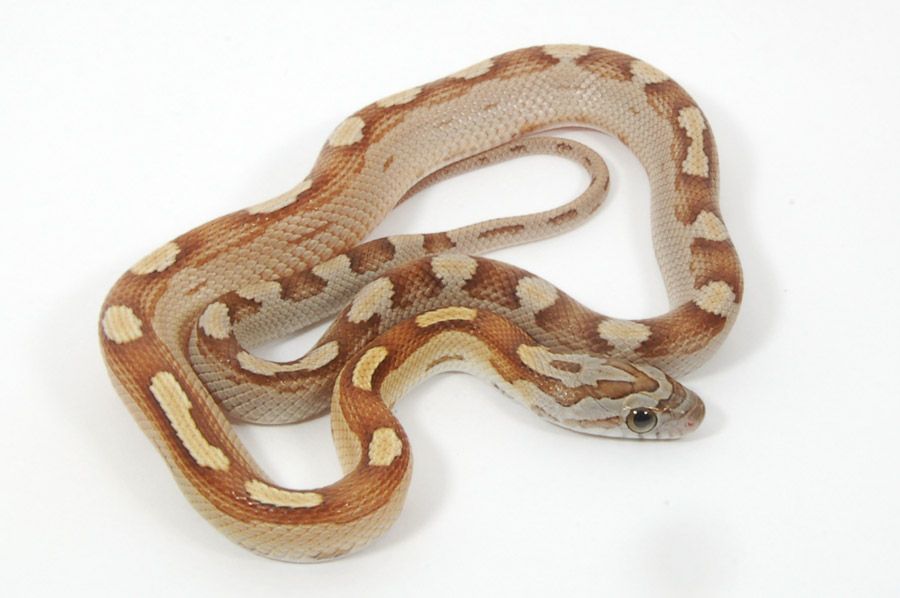
This is a pic of a freshly shed sibling; a classic motley.
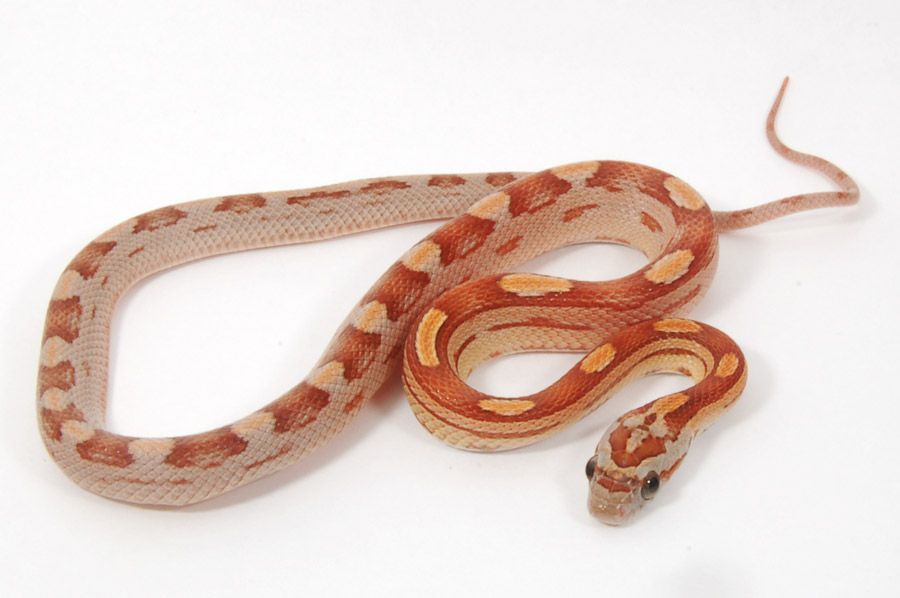
Last, here's the two of them together so you can really see the difference in color. These are siblings from the same clutch. Like I said, it has to be a caramel motley.
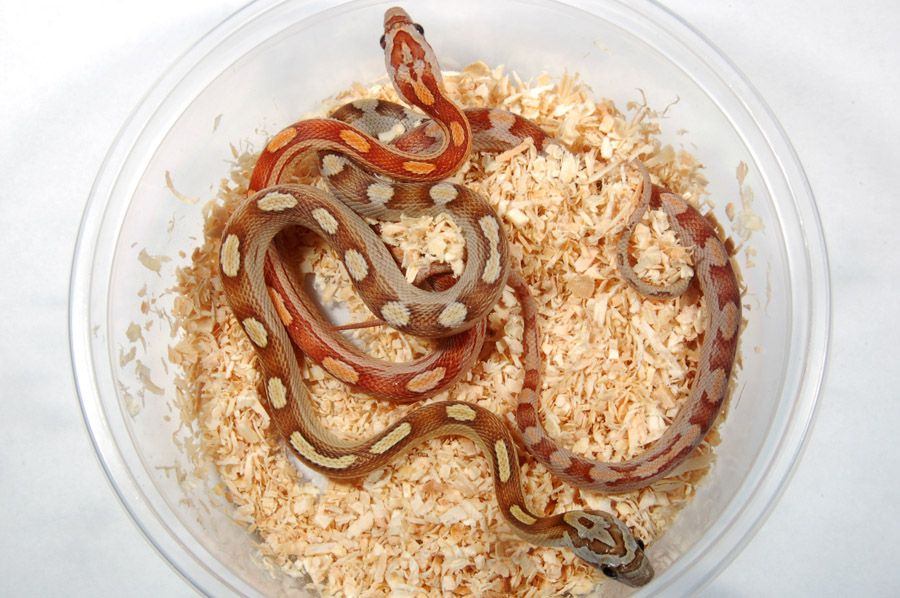
Here's a pic of the snake after his latest shed; I'm now convinced is a caramel motley.

This is a pic of a freshly shed sibling; a classic motley.

Last, here's the two of them together so you can really see the difference in color. These are siblings from the same clutch. Like I said, it has to be a caramel motley.

slangenbroed
New member
Sorry you made one big mistake Buf is not from a caramel line, the first buf came out of a amel x normal het amel . So the start in your story is wrong.I know this is a sensitive subject and I respect the guy who proved out Bufs. It took him many years to be able to convince the right people that his theories were true. I fully support his theories.
Bufs came from a Caramel line which is why it took him so long to prove it out. The fact that it came from Caramel lines also links Bufs to the same lineage as Caramel, but how far back is their ancestry linked? When I speak of Caramel lines, this includes all lines, such as Butter Motleys, Striped Butters and Goldust.
If we find a gene in our Caramel lines in the USA that acts exactly the same as Buf, is it actually Buf? You tell me how we are to prove that. I think the only guy in the USA that will be able to establish if Buf is the same as Yellow Factor is Chuck Pritzel under a microscope.
Since Buf came from Caramel lines and all Caramel lines trace back to Rich Z, it seems reasonable to assume that Buf may have existed in Caramel lines in the USA before Buf was described. Like many of our other genes, it could have went completely unnoticed right under our noses. An example is Diffused. We looked at this gene for decades until someone one like Chuck came along and said, hey wait a minute, I see something that is more than selective breeding, just like the discover of Buf.
Here are two links to ACR registered Corns that I consider Yellow Factor. They were born in 2004 from a breeding between a Wild Line Lava ("Landrace" Lava) x Rich Z Butter Motley.
http://herpregistry.com/acr/Registry.php?idnum=2087
http://herpregistry.com/acr/Registry.php?idnum=2088
These two males are the ones I held back from the project, which I call my Topaz Project. Three things stood out to me in the F1 offspring. All offspring were Yellow Factored, some of them were RedCoats and ALL of them were Border-less. This breeding should have produced Normal Corns with some type of border. They were not "yellowish", "reddish" or partially "border-less", the changes in F1 were dramatic. How could anybody look at these two males and say they are Normal Corns?
There has been a constant debate over the years if Caramel is actually recessive or could it be co-dominant. I am not the only one who sees Yellow Factored Corns produced from Caramel lines, many people have seen it. Many people see two phenotypes in Caramels, Butters, Butter Motleys and Striped Butters. I have seen these same differences in phenotypes in Caramel lines too. It is not just variation, or something we can diminish by saying they are just more "yellowish". It is not hypo, because they are not Ambers, but it is a gene that has hypomelanistic effects.
Since Buf came from a Caramel line, why is it so hard to believe that Buf exist in the USA? I do not know if Buf and Yellow Factor are the same gene, but they are both dominant genes that cause Yellow in F1. It seems likely to me that they are one and the same.
I have personally never seen a Buf or Amel Buf in person that links back to the Buf lineage from the Originator, but I have seen 100's of Corns that look like the same phenotype and MAY be of the same genotype. It seems likely that Buf and Yellow Factor are the same thing, especially since they both come from Rich Z Caramel lines.
Greatings Jan.
slangenbroed
New member
There is only one witness of the original Corn that started the Caramel line. If you read one of his post above, his description to me sounds like a Yellow Factor het Caramel, or perhaps a Yellow Factored Caramel. If Caramel and Buf/Yellow factor have always been combined, then this definitely explains the different phenotypes we see in Caramel lines.
Lemon colored Butters would actually be Buf Butters, and butterscotch colored Butters would be straight Butters. We often selectively breed things like Lavenders, with only Lavenders to choose from, and never see what the Normal Phase of our Lavenders look like.
When I outcrossed an Amel Striped X Lavender het Amel to produce my original Striped Lavender Project, I produced offspring that could have been called Buf Amels and Bufs het for Striped Amel Lavender that were all Border-less. When I bred them together to produce my first Striped Lavender, I think I produced just about every phenotype possible in Amel, Lavender, Striped, Cubed, Okeetee and Normal.
.
Buf has no relation to caramel i beliefe,i bred buf-amel ( orange ) to butter several years back 2009 i belief outcome amel and orange , no butters, some may say now the orange are het caramel that the reason, but they are all het caramel. I bred orange to golddust x orange outcome 4 amel-1 orange-5 ultramel-4 ultramelbufs, here again no butters and no golddusst.
slangenbroed
New member
Here we go again...
yep................................................
slangenbroed
New member
Here are some pictures of our Buf. The color seen in the photos is accurate of his true color. As you can see, Buf looks *nothing* like Caramel.
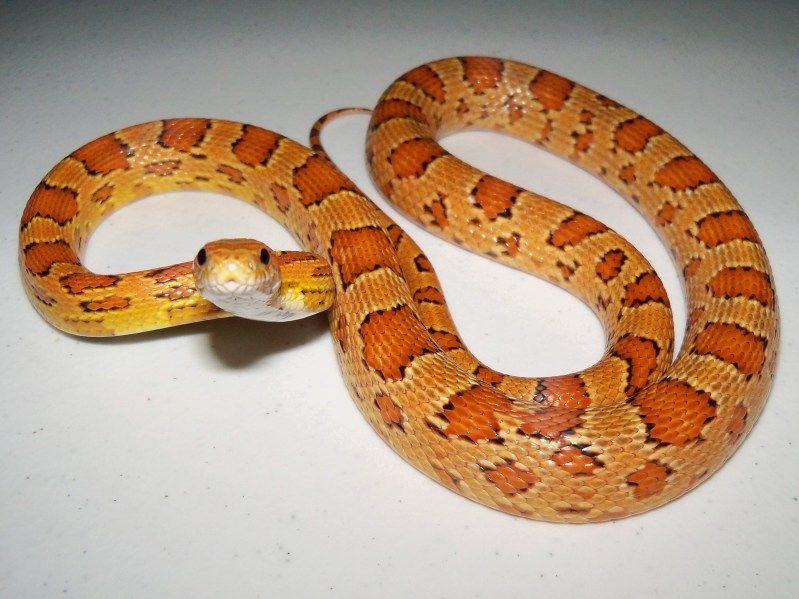
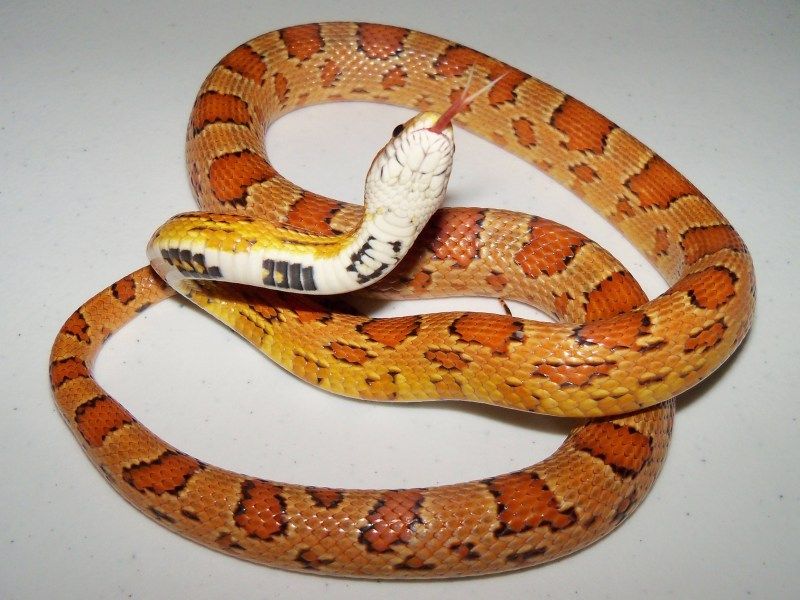
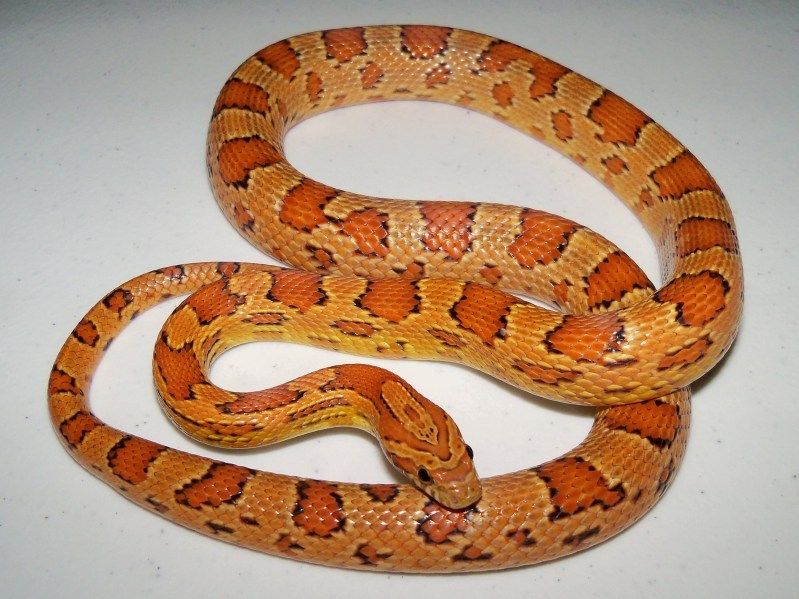
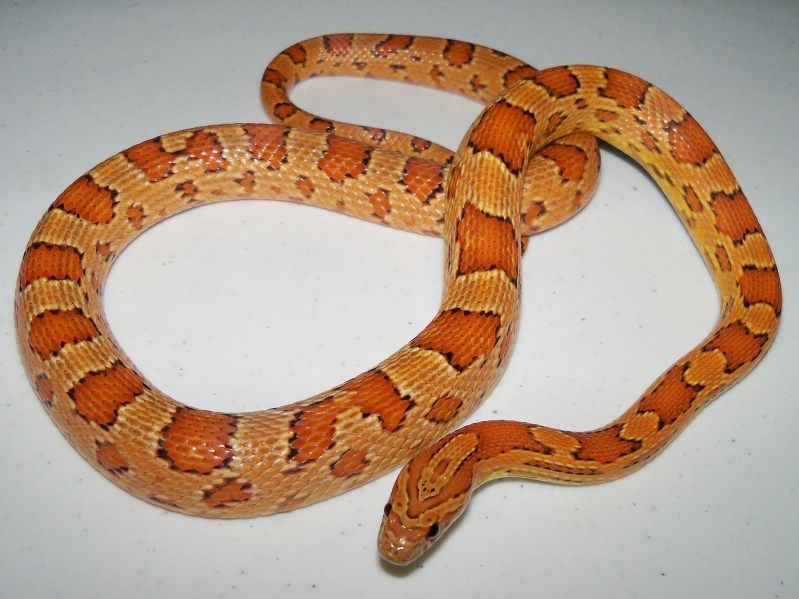

That looks indeed like buf.
slangenbroed
New member
May i aske from who you have theese bufs, just to now from what line they are.Becouse i have several lines in buf, and they al look a little different.If iam correct then i now witch line.Those are definitely very odd colored "normals," so I can see why one would think something "more" is going on. My guess would be some other gene over it being Buf. I'm by no means a pro at Buf, but it does not have the same look that other Bufs have. Once our Buf finishes digesting his meal, I will post a photo. Oh, and it is directly from the line from Holland.
iculatr
NO...WIRE...HANGERS!!!
May i aske from who you have theese bufs, just to now from what line they are.Becouse i have several lines in buf, and they al look a little different.If iam correct then i now witch line.
Our Buf came from Chuck Pritzel. Here is the ACR page: http://herpregistry.com/acr/Registry.php?idnum=7975
slangenbroed
New member
Ok that what i was thinking the phantom line, the buf from charles is a offspring from Orange ( buf amel ) x phantom.The buf's from charles are het amel-hypo and charcoal, he got it from me in 2010 as a adult couple, only the female was not a big one at that time, so i beleef he didn't breed with that female in 2011.If iám correct you have the offspring from 2011 ?Our Buf came from Chuck Pritzel. Here is the ACR page: http://herpregistry.com/acr/Registry.php?idnum=7975
Good luck with him ore here, and if you have questions i will be glad to answer thoose.Please keep in touch with me so i wil now what is happening with buf in the states, and second are you the only one who has buf from charles ?
Greatings
JAn
iculatr
NO...WIRE...HANGERS!!!
Ok that what i was thinking the phantom line, the buf from charles is a offspring from Orange ( buf amel ) x phantom.The buf's from charles are het amel-hypo and charcoal, he got it from me in 2010 as a adult couple, only the female was not a big one at that time, so i beleef he didn't breed with that female in 2011.If iám correct you have the offspring from 2011 ?
Good luck with him ore here, and if you have questions i will be glad to answer thoose.Please keep in touch with me so i wil now what is happening with buf in the states, and second are you the only one who has buf from charles ?
Greatings
JAn
Yep, this is a 2011 male.
